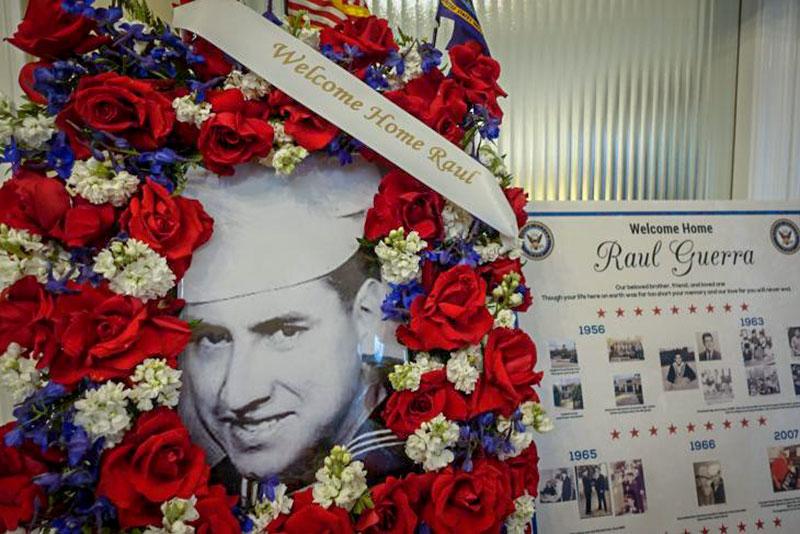

Close to 52 years ago, a young Navy reservist from Montebello, California died in a plane crash in a remote mountainous area in Vietnam.
For decades, the U.S government couldn’t recover Raul Guerra’s remains — initially because of weather conditions and later because of the steep terrain. Nearly 40 years later, even when his body was returned stateside, Guerra’s case posed another challenge: he was originally adopted in Mexico, and no blood relatives were available to provide a positive DNA match.
Forensic science had to advance for more than a decade before the Department of Defense could finally make a positive identification.
After more than a half-century of waiting and a dozen years of effort by his friends, Guerra finally was laid to rest in April.
The Best Man
Raul Guerra and Ruben Valencia first bonded back in the fifth grade at Montebello’s Eastmont Elementary. Valencia remembers the day their teacher introduced Guerra, a new student, in front of the class and assigned Valencia to walk him around the school.
“He was as smart as could be,” Valencia said. “And from that day on, we were just best friends.”
The boys had much in common. They were raised by single moms with jobs outside the home, a rarity in the ‘50s and ‘60s. Guerra was on the quiet side, intellectual with a mischievous sense of humor.
“While our mothers were working, Raul and I were sort of always watching out for each other,” Valencia said.
Both graduated from Montebello High School in 1963. That’s also the year Valencia began dating a pretty classmate named Emily, who was one grade behind him.
“I told Raul that I thought I’d met the girl I’m going to marry,” Valencia said. “I told him, ‘You’ll be my best man, right?’ And he told me, ‘Would there be anybody else?’“
The couple married in June 1965 at Our Lady of Lourdes in East Los Angeles and yes, Valencia’s best man was there.
Meanwhile, Guerra was making a name for himself in journalism. He was an award-winning writer and editor for the high school paper and later worked at East L.A. College’s campus publication.
That’s where he met his bride to be.
“We were rivals,” remembered Mary Barrow Somerlott. The two young reporters were jointly awarded the same journalism prize at ELAC. “The scholarship was all of $100, but it bought my books.”
They began as friends but started dating a couple of years later. “We fell in love with love,” Somerlott said. “But timing is everything, especially in wartime.”
Friends Go Off To War
The likelihood of being pulled into the conflict in Southeast Asia loomed large over the young men’s lives. Guerra enlisted in the Navy Reserves, thinking it would buy him some time to develop his career. Valencia was drafted in 1965.
He joined the Marine Corps, assuming he’d be stationed close to home at Camp Pendleton.
“I didn’t know they already had our tickets to go to Vietnam set up,” Valencia said. He arrived in Vietnam in July 1966. The friends wrote letters back and forth.
“[Raul] was always telling me, ‘I wish I could trade spots with you because you could be with Emily. It’s safer for you,’” Valencia said. “I would tell him, ‘Don’t worry about me, I’m going to get home. I know I’m gonna come home.’”
After graduating, Guerra got a job as a sports editor for the Montebello News, but in 1967 was activated to ship off to Vietnam.
Valencia was awarded the Purple Heart for injuries he received in May 1967.
“We were surprised by the Viet Cong,” he said. “There were explosions that went off. I ended up having shrapnel in the backside. Several of our people ended up getting killed that day.”
He was medevaced out of the Vietnamese jungle to a hospital ship and ultimately home to recuperate in the Los Angeles area.
“I felt bad because my friends died over there, and yet I still had my eyesight and both of my hands, both of my feet,” Valencia said. “But I always thank God for that because I think [Raul] was always watching out for me.”
It was October 1967, and Ruben Valencia had only been home from Vietnam for a couple of months when he got a call from Raul Guerra’s mother.
“Right away, we knew it wasn’t going to be good news,” Emily Valencia said. “It was very hard for him, and it still hurts him a lot. And what hurts him, hurts me.”
A plane carrying five people, including Guerra, was en route from Chu Lai Air Base back to the USS Oriskany when it crashed into a rural mountainside north of Da Nang. Guerra was missing in action and presumed dead.
Valencia believes Guerra volunteered for the flight in order to get a sense of where his best friend had served.
“He wanted to go over there where I was in Vietnam,” Valencia said. “He got the opportunity to get onto a plane so he could see where his buddy was at. That was the sad part. It was the very first time he got into Vietnam.”
The shock of the loss rippled across the Montebello community.
“I don’t remember who called me. I just remember driving home from my job in Los Angeles, alone in grief and convulsing in tears,” said Mary Somerlott. “I was 22 years old. And I had never before experienced the death of someone I loved.”
The Long Wait
It took the U.S. government nearly 40 years to recover the wreckage of the E-1B Tracer aircraft. It was discovered by a farmer who came across the crash site and decided to see if there was any scrap metal to salvage.
“He ended up gathering the remains of these people, now, you have to think this is 40 years, so he didn’t have much to bring down off the hill, but he did have respect to bring them down and bury them in his village,” Valencia said, referencing a report delivered to him by the Navy. “Later on, he let somebody know that he had the remains.”
Vietnamese investigators were alerted to the crash site in 2004. The U.S. government received possible human remains from the wreckage the following year.
The Pentagon team responsible for identifying, recovering, and reuniting fallen service members with their families is known as the Defense POW/MIA Accounting Agency. The department employs archeologists, anthropologists and other forensic scientists for the highly specialized work of identifying “residual remains,” the cold cases of military casualties.
The DPAA said more than 1,500 American servicemen and civilians remain unaccounted for from the Vietnam War.
“We look at skeletal remains, bones and teeth, because the cases are typically decades old. Anywhere from 30- to 75-year-old cases,” said John Byrd, the DPAA Laboratory Director. “After so many years, we’re dealing with the remnants of a person to try to identify them to a very high forensic standard.”
The remains from Guerra’s 1967 crash were sent back to the DPAA’s lab at Joint Base Pearl Harbor-Hickam, Hawaii.
Four other passengers on the plane were quickly identified using DNA testing. But Raul Guerra’s journey home would not be so straightforward. Unbeknownst to Guerra’s friends, he was adopted and brought to the U.S. from Mexico.
“We never knew that Raul’s mother, who I had always known as being his mother, was not his biological mother,” Valencia explained.
The full story of Guerra’s birth and adoption has been lost. Despite the best efforts of Valencia and researchers working to trace his family history, there appears to be no paper trail of how he came to live with his mother, who has since passed away.
“She, unfortunately, took it to the grave with her,” Valencia said.
To help solve the mystery, researchers with Brigham Young University conducted a genealogical study that traced Guerra’s ancestry to Ensenada, Mexico. Those investigators made a surprising discovery: the man they believe was Guerra’s biological father was actually an American from Whittier, California, who also had a business in Mexico.
“Raul never knew this,” Valencia said. “I also never knew my biological father. So this was maybe another thing that drew Raul and I together.”
They also uncovered a birth certificate, which stated Guerra was born in 1942, but it’s unclear how accurate that record was. The identity of his birth mother in Ensenada remains a mystery. The biological father had one surviving daughter, but she chose not to volunteer to take a DNA test.
“All we can go on is who Brigham Young University feels is his biological family,” Valencia said. “But nobody wanted to step up at that time.”
A Match Is Made
It took key advancements in forensic science to finally positively identify Guerra’s body.
According to Byrd, the DPAA has family DNA for about 85 percent of missing Vietnam War servicemembers. The remaining 15 percent of cases don’t have reference samples available and present a greater challenge.
“It’s a setback that we do encounter fairly often,” Byrd said. “So we find other ways to put the case together.”
In Guerra’s situation, it was an emerging technique called “stable isotope analysis.” The approach uses samples from different parts of a skeleton to tell scientists where the person grew up and where they lived during their lifetime.
DPAA investigators looked at the presence of oxygen isotopes in the bone fragments, which come from drinking water. Ratios of oxygen isotopes vary across the globe.
Comparing the isotope ratios in a skeleton to maps of oxygen ratios in different parts of the world lets scientists track a person’s movements.
“We found data from water supplies in Mexico and Southern California, and we were able to use that technique to show that the remains from the site were a good match to the geographic life history of Raul Guerra,” Byrd said.
That match was officially confirmed in February.
Anthropology and archeology departments have researched this method for years, but they only handle a few cases a year. The DPAA is on the forefront of developing stable isotope testing on a large scale for identifying human remains, Byrd said. The department hopes to ramp up testing in the coming months.
“We’re looking at doing thousands of samples a year. We have a large scope of work,” Byrd said. “There won’t be anything else at that scale, that I know of, anywhere in the world.”
The science is promising but for family and friends of Raul Guerra, the bottom line was their long-lost brother was finally headed home.
After 52 years, Ruben Valencia and Raul Guerra were reunited. On March 20, a Navy delegation arrived at Valencia’s doorstep, carrying paperwork to release the remains.
“There were times that I was a little bit tired, but I don’t think I ever felt I could give up,” Valencia said. “This was my friend. This was my brother.”
This story was produced by the American Homefront Project, a public media collaboration that reports on American military life and veterans. Funding comes from the Corporation for Public Broadcasting









